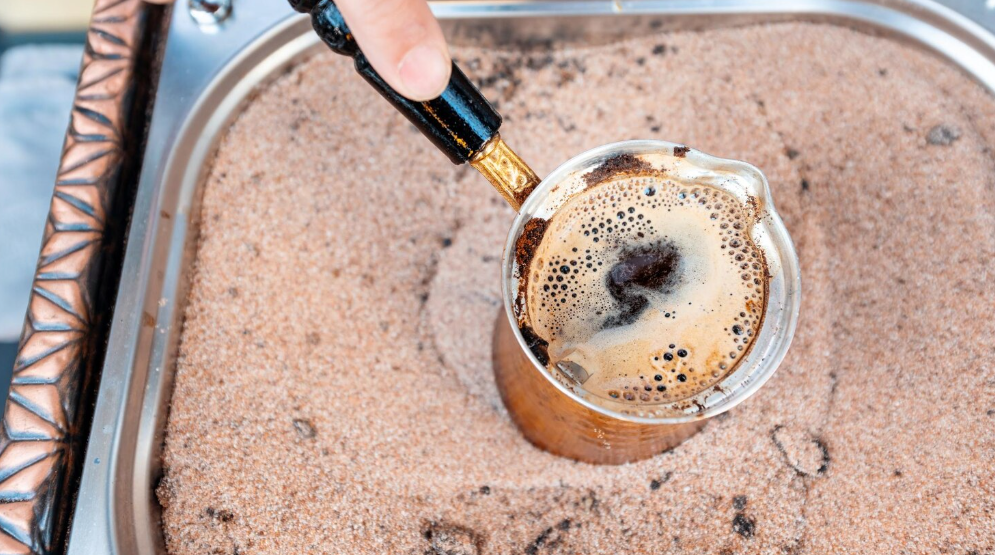FOOD
Gibraltar Coffee: The Smooth, Bold Brew with a Cult Following

Gibraltar coffee is a specialty café drink that blends the boldness of espresso with the creaminess of steamed milk, resulting in a small yet intensely flavorful beverage. Known for its velvety texture and balanced flavor, it has developed a passionate following among coffee enthusiasts and baristas alike. While many people mistake it for a cortado, a Gibraltar has a unique history, specific serving glass, and a flavor profile that sets it apart. Its origins trace back to San Francisco’s specialty coffee scene, and today it has carved out a niche for those who crave a drink that lies between the intensity of espresso and the milk-forward smoothness of a latte.
The Origin Story
The birth of the Gibraltar coffee can be traced to Blue Bottle Coffee in San Francisco in the mid-2000s. Baristas there began serving a cortado-like drink in a short, sturdy 4.5-ounce Libbey Gibraltar glass. Customers soon began referring to the beverage simply as “a Gibraltar,” and the name stuck. Unlike many drinks named after preparation style, the Gibraltar’s identity is tied directly to its vessel. This glass became symbolic not just of the drink’s size, but also of its no-nonsense, artisanal coffeehouse vibe. It was a barista’s drink—made quickly, served without ceremony, and consumed while still at perfect drinking temperature.
The Signature Glass
The defining feature of a Gibraltar is its distinctive Libbey Gibraltar glass. Holding exactly 4.5 ounces, this glass is heavy, clear, and designed for durability in busy cafés. Its weight and thickness keep the drink warm while allowing the drinker to appreciate the rich color of espresso topped with silky microfoam. The glass’s slightly tapered shape also makes it easy to hold, enhancing the casual and approachable feel of the drink. In coffee culture, presentation matters almost as much as taste, and the Gibraltar glass has become an icon in itself—often recognized instantly by coffee aficionados.
Composition and Ingredients
At its core, a Gibraltar is built from two simple elements: double espresso and steamed milk. The espresso base is made using freshly ground, high-quality coffee beans, ideally roasted to bring out a balance of sweetness, acidity, and body. The milk is steamed to a texture known as microfoam—smooth, creamy, and without large bubbles—providing a seamless mouthfeel. The drink contains roughly equal parts espresso and milk, making it stronger than a latte yet softer than a straight espresso. The proportions create a perfect balance that allows the character of the coffee beans to shine without being overwhelmed by milk.
Brewing the Perfect Espresso Base
A true Gibraltar begins with a well-extracted double shot of espresso. Baristas typically aim for a brew ratio of 1:2, meaning that for every gram of coffee grounds, two grams of espresso liquid are produced. Extraction time usually falls between 25 and 30 seconds, depending on bean origin and roast profile. The goal is to create a balanced shot with pleasant acidity, natural sweetness, and enough body to stand up to the milk. Poorly extracted espresso—whether underdeveloped or bitter—will make the entire drink fall flat, as the small size of a Gibraltar leaves little room for error.
Steaming the Milk to Perfection
Milk preparation is critical for a Gibraltar. Unlike a cappuccino, which uses airy foam, or a latte, which has a thinner microfoam layer, the Gibraltar requires milk steamed to a velvety consistency that integrates smoothly with the espresso. The milk should be heated to around 55–60 °C (130–140 °F), slightly cooler than for larger milk drinks, to ensure the drink can be sipped immediately without burning the tongue. This temperature also preserves the milk’s natural sweetness, preventing it from developing a cooked taste. The result is a rich, silky texture that blends harmoniously with the coffee’s intensity.
Flavor Profile
A Gibraltar delivers a flavor experience that is simultaneously bold and smooth. The concentrated espresso provides depth and complexity, often with notes of chocolate, caramel, fruit, or nuts, depending on the bean origin. The milk tempers the acidity and rounds out the flavor, resulting in a beverage that is more approachable than straight espresso but far less diluted than a latte. Many describe it as “espresso with training wheels” for those developing a palate for stronger coffee. The balance between coffee and milk makes it versatile—pleasing both seasoned coffee drinkers and newcomers to specialty coffee culture.
Gibraltar vs Cortado
The Gibraltar is frequently compared to the cortado, and with good reason: the two drinks share nearly identical ratios of espresso to milk. The key difference lies in presentation and cultural association. A cortado is a Spanish-origin beverage traditionally served in a small glass or cup, often slightly smaller than the Gibraltar’s 4.5-ounce vessel. In the United States, the term “Gibraltar” emerged as a café nickname for a cortado served specifically in the Libbey glass. Over time, the Gibraltar evolved into its own identity—still essentially a cortado in composition, but with a distinct visual style and West Coast coffeehouse heritage.
Gibraltar vs Flat White
Another point of comparison is the flat white, a drink with roots in Australia and New Zealand. A flat white is larger than a Gibraltar, usually served in a 5–6-ounce cup, with a slightly higher milk-to-coffee ratio. The milk in a flat white is also steamed to a similar microfoam texture, but because of the larger size, the espresso flavor is somewhat more subdued. In contrast, the Gibraltar’s smaller volume allows for a more intense coffee presence, making it a better choice for those who want a quick, flavorful drink rather than a lingering milk-based beverage.
Popularity in Specialty Coffee Shops
Although the Gibraltar started as a quiet café insider’s order, it quickly gained mainstream popularity in specialty coffee circles. Many third-wave coffee shops now list it on their menus, while others continue to treat it as a “secret” item for those in the know. Its size makes it ideal for customers who want a satisfying coffee experience without committing to a large cup, and its approachable flavor profile appeals to a wide range of tastes. In cities like San Francisco, Los Angeles, New York, and Portland, ordering a Gibraltar has become a subtle nod to being part of coffee’s inner culture.
Cultural Symbolism
The Gibraltar is more than just a drink—it’s a cultural symbol of the third-wave coffee movement’s emphasis on craftsmanship, transparency, and quality. It embodies the idea that coffee can be both artisanal and approachable, elegant yet unpretentious. Served in a simple glass without elaborate latte art competitions or exotic syrups, the Gibraltar represents a back-to-basics approach that values raw quality over gimmickry. For many, it also evokes the communal, conversational atmosphere of independent coffee shops, where baristas and customers share a mutual appreciation for thoughtfully prepared beverages.
Preparing a Gibraltar at Home
Making a Gibraltar at home is entirely possible with the right equipment. You will need an espresso machine capable of producing consistent, high-pressure extraction, a burr grinder for fresh coffee grounds, and a steam wand for texturing milk. Start by pulling a double shot of espresso into a pre-warmed Gibraltar glass. Steam about two ounces of milk to microfoam texture, ensuring the temperature stays within the optimal range. Pour the milk gently over the espresso, aiming for a seamless integration rather than thick foam separation. The result should be a warm, balanced drink ready to enjoy immediately.
Bean Selection for Optimal Flavor
Because the Gibraltar is such a small drink, bean quality plays an outsized role in its flavor. Many baristas recommend medium-roast beans for their balance of sweetness and acidity, though lighter roasts can create a brighter, fruitier drink, and darker roasts can yield a richer, more chocolate-forward profile. Single-origin coffees are popular for showcasing distinctive flavor notes, while blends can provide a well-rounded, consistent taste. The key is freshness—coffee should be used within two to three weeks of roasting for peak flavor.
Milk Choices and Alternatives
While traditional Gibraltars use whole cow’s milk for its richness and mouthfeel, alternative milks have become increasingly popular. Oat milk is a favorite for its creamy texture and mild sweetness, which complements espresso well. Almond milk adds a nutty note, while soy milk creates a slightly denser body. Each alternative requires careful steaming, as different proteins and fats affect foam stability. For the best results, choose barista-formulated plant milks designed to perform like dairy in espresso drinks.
Serving Ritual and Timing
Part of the charm of a Gibraltar lies in its immediacy. The drink is intended to be served quickly after preparation, ideally consumed within a few minutes to enjoy its optimal temperature and texture. Unlike a large latte that can be sipped over a long conversation, a Gibraltar is a concise coffee experience—perfect for a short break, a mid-morning pick-me-up, or a post-lunch indulgence. The ritual of preparing, serving, and enjoying it swiftly captures the essence of high-quality coffee culture: fleeting, but memorable.
Global Spread and Variations

While the Gibraltar began in San Francisco, it has found its way onto menus around the world, particularly in cosmopolitan cities with thriving specialty coffee scenes. In some places, cafés put their own twist on the drink—adding a sprinkle of cocoa powder, infusing the milk with spices, or even serving it over ice in warm climates. Purists argue that such variations dilute the drink’s identity, while others see them as an evolution of a beloved classic. Either way, the Gibraltar continues to inspire creativity among baristas and home brewers alike.
Why It Stands Out in the Coffee World
The Gibraltar has carved its own space in the coffee world by offering a perfect midpoint between intensity and comfort. Its size makes it efficient for those on the go, while its flavor complexity satisfies even the most discerning palates. It avoids the heaviness of larger milk drinks and the intensity of straight espresso, offering instead a harmonious balance that feels both indulgent and refined. This adaptability is part of why it has endured and expanded beyond its original West Coast roots.
Conclusion
Gibraltar coffee may be small in size, but its influence on specialty coffee culture is substantial. Born from a café quirk, it has evolved into a globally recognized drink that symbolizes quality, craftsmanship, and approachability. With its signature glass, precise proportions, and rich yet balanced flavor, the Gibraltar offers an experience that resonates with casual coffee drinkers and connoisseurs alike. Whether enjoyed in a bustling San Francisco café or made at home with care, this modest drink proves that sometimes, the best things in coffee come in small glasses.
-

 Tech1 year ago
Tech1 year agoHow to Use a Temporary Number for WhatsApp
-

 Business2 years ago
Business2 years agoSepatuindonesia.com | Best Online Store in Indonesia
-

 Social Media1 year ago
Social Media1 year agoThe Best Methods to Download TikTok Videos Using SnapTik
-

 Technology1 year ago
Technology1 year agoTop High Paying Affiliate Programs
-

 Tech8 months ago
Tech8 months agoUnderstanding thejavasea.me Leaks Aio-TLP: A Comprehensive Guide
-

 FOOD10 months ago
FOOD10 months agoHow to Identify Pure Desi Ghee? Ultimate Guidelines for Purchasing Authentic Ghee Online
-

 Instagram3 years ago
Instagram3 years agoFree Instagram Auto Follower Without Login
-

 Instagram3 years ago
Instagram3 years agoFree Instagram Follower Without Login


















